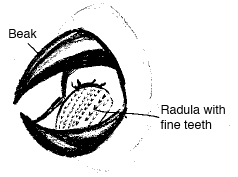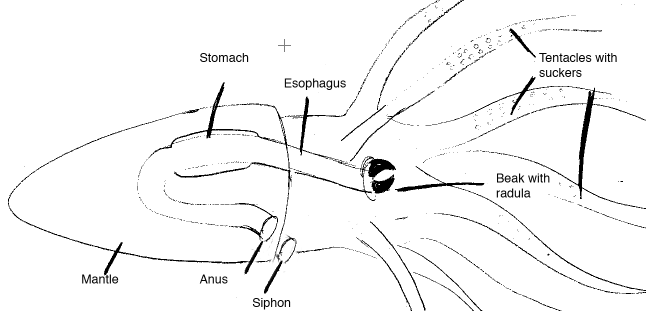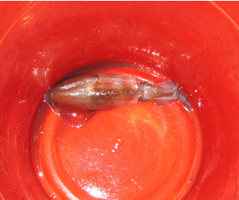Squids (Cephalopoda)
Introduction
Squids belong to the group of mollusks called cephalopods, which include octopi, cuttlefish, etc. Under this order, there are many subcategories of squid. For example, squid that secrete luminescent ink are classified in the genus Heteroteuthis of the family Sepiolidae. The common squid of the east North Atlantic coast belongs to the family Loliginidae. The giant squid belongs to the genus Architeuthis in the family Architeuthidae. The group of marine biologists who study cephalopods are called Teuthologists.
Characteristics
Squids (Fig. 1) are a diverse group of invertebrates (there are estimated to be about 375 species of squid), the smallest squids are only about 2.5cm in long (Idiosepius sp.), but the largest giant squid recorded by far was about 20 meters long and weighed more than 1000 pounds, and that is about as big as two school buses! Giant squids are the largest invertebrates in the world, their eyes, which are bigger than the size of your head, are even bigger than those of the world’s largest vertebrate – the blue whale’s. The largest nervous system in the animal kingdom also belongs to the giant squid.
Squids are soft-bodied, and generally have 2 muscular tentacles and 8 powerful arms. Those of the giant squids reach a length of 10 meters for the tentacles, and 3 meters for the arms. The tentacles are what are used to catch prey. The lower surface of these arms is covered with two rows of suckers. The tentacles of squid and octopi do have a difference. Squids have extra armature-hooks on the sucker rings. This allows for them to grasp hold of their prey. Their mouth is hidden in the center of the mass of arms. It looks like the beak of a parrot, with a hard upper and lower mandible. Inside the mouth is a rough tongue, called a radula, which has teeth on the sides (see Fig. 2).
Squids have a siphon in their mantle cavity to expel water and waste, and use this jet propulsion to move around. Squids are known for their ability to change colours, either to protect themselves by blending into the environment, or to attract mates during courtship. The squid has transluscent skin, and its colours come from chromatophores, which are pigment cells on the outer layer of the skin. These pigment dots expand and contract to show or hide certain colours like red, yellow, black, green, blue, etc.
Habitat
All kinds of squids are free to swim around in the sea at different depths. Giant squids lurk in depths of 660 to 2300 feet under the sea. The giant squids are a delicious meal to sperm whales, while the tinier ones are snacks to albatrosses, fish, and even humans. Squids usually swim at around 23mph, using the paired fins at the rear of the mantle, together with gentle pulses of water pushed out of the mantle cavity through the funnel, which doesn’t make them the fastest swimmers in the sea. Therefore, in order to survive and protect themselves, squid change in colour to blend in with their surroundings, and under certain circumstances, squids squirt out black, mucous ink from a large, elongated sac to confuse predators. The pattern in which squid move, pumping water through the mantle, is also how squid breathe. Most sea animals have visible gills, but squids do not possess gills like most fish do, instead they obtain oxygen through a pair of long ‘gills’ covered in leaflets called lamellae. When fresh water is pumped in, the squid’s gills are also refilled with oxygen.
Specific adaptations to the environment
The squid’s large eyes help it detect even the smallest amounts of light deep under the sea where it usually dwells. The squid’s diet is composed mainly of fish and crustaceans. The suckers on the squid’s arms are used to capture and grasp on to prey, bringing it toward the powerful beak, also known as a mandible. Once the food is passed to the mandible by the arms, it undergoes intensive chewing before going into the esophagus. The radula (see Fig. 2) has rows of fine teeth that cover a tongue-like muscle in the squid’s mouth. It is specially adapted to drill through and shred crustaeceans or other mollusks with shells. The food needs to be finely ground since the squid has a one-tract digestive system (see Fig. 3), which passes through the squid’s brain. Talk about getting a brain freeze!
Reproduction and Life cycle
Cephalopods grow into maturity in a very short time, from 3 – 5 years. Squids do not live a very long life, which is why females release such enormous amounts (up to 11 pounds) of eggs to ensure the continuation of their species. Squids usually spawn in groups. Males store packets of sperm called spermatophores in specialized, long arms, which are penetrated through the female’s mantle during a mating session of just 15 seconds. While most squid lay their eggs in masses on the sea bed, some squid carry a clutch of eggs to guard them. The adult squid does not live long after mating. Baby squid hatch as larvae and grow into maturity in about 3-5 years.
What is the importance of squid to the ecosystem?
Due to bioaccumulation, squid like most predators would build up heavy metals and toxins if exposed to pollution. Squids are very sensitive to any changes in water quality, and will swim to cleaner areas. Therefore, an area that is largely populated by squid should indicate clean waters. Its abundance is also an importance of this organism to the ecosystem; a lot of predators like sperm whales, sea birds and seals depend on squid for food.
Are squid common or endangered?
Squids generally are common around the globe, with the exception of Giant Squids. We do not know a lot about Giant Squids as they live too deep under the ocean and sightings are rare. As for the more common species, their numbers are so vast that humans regularly fish for squid (Fig. 4). According to research reported on ABC News, the total body mass of squid on Earth has far exceeded the mass of humans. It is even predicted that rise of global temperature will speed up metabolism and growth in Cephalopods, resulting in a Squid bloom.
Information on the Internet
- Could Warming Lead to Squid Boom? How many squids are there to eat? There are more than enough squids to go around for everybody and the numbers are increasing steadily due to global warming.
- The Colours of California Squid Article on Squid pigment organs and how they work.
- Giant Squid and Colossal Squid Fact Sheet General information on the Giant Squid.
- Squid A diagram of the anatomy of a squid.
- Architeuthis dux A group of scientists in search for the giant squid.








 Go to quick links
Go to quick search
Go to navigation for this section of the ToL site
Go to detailed links for the ToL site
Go to quick links
Go to quick search
Go to navigation for this section of the ToL site
Go to detailed links for the ToL site